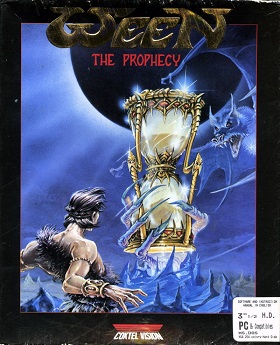
Starship Titanic is an adventure game developed by The Digital Village and published by Simon & Schuster Interactive. It was released in April 1998 for Microsoft Windows and in March 1999 for Apple Macintosh. The game takes place on the eponymous starship, which the player is tasked with repairing by locating the missing parts of its control system. The gameplay involves solving puzzles and speaking with the bots inside the ship. The game features a text parser similar to those of text adventure games with which the player can talk with characters.

System's Twilight: An Abstract Fairy Tale is a graphical interactive fiction computer game created by Andrew Plotkin and released in 1994.

Nightfall is an American computer game released in 1998 by Altor Systems, Inc. Although claimed to be the first real-time 3D first person adventure game, there are earlier examples of 3D first person adventure games, however, such as Total Eclipse, released in 1988. It employs a three dimensional world and sprites for objects such as vases and rats, as well as true 3D objects such as blocks and statues. Essentially, the gameplay is a combination of 3D first-person shooters such as Doom, the gameplay found in Myst, with some additional elements.

Frankenstein: Through the Eyes of the Monster is a point-and-click adventure video game that stars Tim Curry as Dr. Frankenstein, and has the player controlling a newly created Frankenstein monster. Other cast members include Robert Rothrock as the voice of the monster, Rebecca Wink as villager Sara, and Amanda Fuller as Gabrielle, the monster's daughter. It used full motion video clips and 3D CGI graphics similar to Myst. The game was developed by Amazing Media and published by Interplay Entertainment Corp for the PC in 1995 and for the Sega Saturn in 1997. The game was given a "Teen" rating by the Entertainment Software Rating Board, but was originally rated as K-A. A port for the Atari Jaguar was in development but never released.

MILO is a first-person adventure-puzzle computer game that challenges the player to solve 14 puzzles based in the world of MILO, an artificially intelligent computer. The game was developed by Crystalvision Software and released in 1996. Released in the wake of such titles as Myst and Pandora's Box, MILO was billed as a multimedia game and as an early example of 3D gaming. The 16-track ambient soundtrack is composed by noted progressive rock musician, Warren Dale.

Crusader: Adventure Out of Time, also known as Crusader: A Conspiracy in the Kingdom of Jerusalem is a 1997 video game, developed by Index+ and published by Europress. The game was published for Windows, Windows 3.x and Mac OS.

The Secret of the Nautilus is a 2002 adventure video game, inspired by Jules Verne's science fiction novel Twenty Thousand Leagues Under the Sea. It was developed by Cryo Interactive and released for Microsoft Windows based PCs.

Anastasia: Adventures with Pooka and Bartok is a puzzle video game based on the 1997 animated film Anastasia. Developed by Motion Works, published by Fox Interactive and distributed by 20th Century Fox Home Entertainment, the title was released on November 25, 1997. It was produced by David Wisehart, who also served as voiceover director. The game had an estimated budget of US$800,000.

Ark of Time is a 1997 adventure game developed by Italian studio Trecision and published in 1997 for MS-DOS by Koei. A PlayStation version was released in 1998.

The Prophecy is a point-and-click adventure game in a fantasy setting, developed by Coktel Vision and MDO, released in Europe in 1992 for MS-DOS, Amiga, and Atari ST. It was published by Sierra On-Line in North America in 1993. A German retail version was released.

Forever Worlds, or Forever Worlds: Enter the Unknown, is an "adventure satire" video game developed by Canadian studio Hexagon Entertainment and released in 2004.

China: The Forbidden City is a 1998 adventure video game developed by Cryo Interactive Entertainment and jointly-published by Cryo, Canal+ Multimedia and the Réunion des Musées Nationaux.

Pilgrim: Faith as a Weapon is a 1997 adventure video game, written by Paulo Coelho, who wrote The Pilgrimage, the novel on which the game is based. Pilgrim has been described as a "commercial cultural heritage game" and "graphic interactive fiction". It is the premiere title of Arxel Tribe and the first in an adventure trilogy, which also includes The Legend of the Prophet and the Assassin (1999) and The Secrets of Alamut (2001).

The Legend of the Prophet and the Assassin is an adventure game by Arxel Tribe. It is the sequel to Pilgrim: Faith as a Weapon. It was released in October 2000 for Windows. The game is inspired by the work of Brazilian novelist Paulo Coelho. A sequel, The Secrets of Alamût was released in March 2001.

Adventure at the Chateau d'Or is a 2001 adventure game, developed and published by Karma Labs.

Chemicus: Journey to the Other Side is a 2001 educational adventure video game by Heureka-Klett as part of Tivola's "Quest for Knowledge" series. A sequel named Chemicus II: Die versunkene Stadt was released in 2002. The game was originally released in Germany.

Bioscopia: Where Science Conquers Evil is a 2001 educational adventure video game. It is a sister game to Physicus and Chemicus.

VR Stalker is a combat flight simulator video game developed by Morpheus Interactive and originally published by American Laser Games for the 3DO.
Nacah is a 2001 educational adventure game developed by American studio Virtue Creations and published by Bible Games Company for Windows. A sequel entitled Derek was released in 2003. Derek was revamped into Isles of Derek in 2005.

Monet: The Mystery of the Orangery is a 2000 educational adventure game developed by index+ and Media Factory, and published by Wanadoo Edition on Windows. The title and the game reference the Musée de l'Orangerie in Paris, France, where eight large Water Lilly paintings by Claude Monet are exhibited.


















